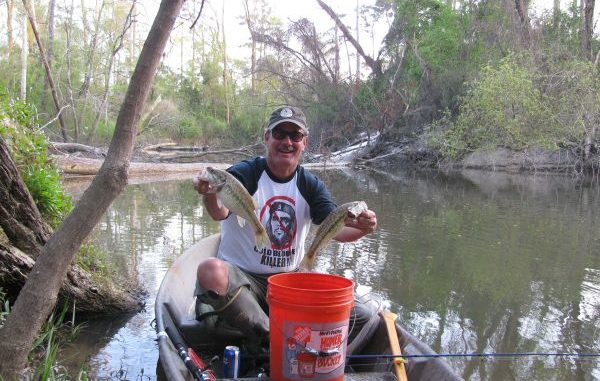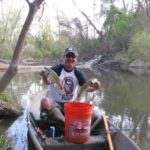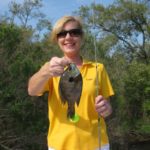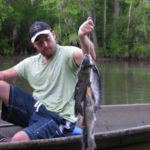
When summer heat makes a day on the water seem almost like work, the cool waters of the Florida Parishes streams offer some relief — and some great fishing.
The weatherman called for a scorcher as Artie called for another beer. But the keg balked — coughing and sputtering and foaming.
Artie cursed and jerked the lever back and forth to no avail. The keg was spent.
“I ain’t all gung-ho about tomorrow’s trip,” Artie said, while giving up on the keg and heading over to the ice chest.
Indeed. Another long haul through the blistering sun through the near-boiling waters of Breton Sound to see if specks would deign to sample our live shrimp — if the tides, water clarity, astrological signs, etc. all fell into place — didn’t seem to excite the crowd at Doc’s Fourth of July bash.
“How ’bout we fish in da shade, tomorrow?” Artie smiled while plucking a dripping brewskie from Pelayo’s “reserve” ice-chest. “How ’bout we head over to the Honey Island Swamp for some poych, lake-runner and green-trout jerking! Da river’s finally down. Poych action’s hot, I hear — as always this time a year over there.”
Pelayo’s brother-in-law Bradley, who had moved down from Atlanta only three years earlier, looked at Artie — then over at us, frowning. He seemed confused.
“Allow me to translate,” Pelayo graciously offered. “What Artie means is: Let’s head into the Pearl River Basin to fish for bluegill, red-eared sunfish and largemouth bass.”
“Ah!” Brad replied. “OK, got it. Well, why didn’t he say so? So you mean the same type of fishing we did around Memorial Day in the swamps around Houma? Thought you guys said that slowed down when the water got hot and filled up with grass, and the spawn sputtered out?”
“This is different fresh-waaw-da habitat,” Pelayo explained. “Up across da lake in those cool, flowing streams ranging from the Pearl River across the Bogue Chitto and Tchefuncte over to the Tangipahoa and Amite — and including all their tributaries and distributaries — in this area the panfish action turns on later, right around June to July. At least that’s when we always do best. The Pearl River system itself is usually high and muddy during the best months of perch jerking in the flotant swamps south and west of da lake. Now it’s low and clear — we see this pattern every year.”
“Sounds like a great idea,” Brad said with a thumbs-up signal. “Especially after that last trip into Breton Sound. Whoo-Boy! I won’t forget THAT one for a while.”
Brad’s wife Amy looked over, grimacing, gasping and rolling her eyes.
We could hardly blame Brad for his thumbs-up and Amy for her gasps of horror. A week earlier both had gotten their fill of Breton Sound summer fishing.
WHOOO-BOY!
Midway to Da Central from da Hopedale rocks, the sky suddenly turned a gorgeous dark grey — almost black. While our tense guests looked around wide-eyed, Eddie, at the helm, kept pounding Central-ward — to the consternation of all aboard, whose faces all urged a quick U-turn.
Soon lovely little white caps topped the waves like frosting on chocolate cake, the swells between them heavily rippled by the savage gusts that had kicked up just seconds earlier.
And Eddie, undaunted, kept pounding eastward into the sound.
An hour earlier, we’d sweltered in the sun, grappling with ropes and ice chests while launching the boat, panting and squirting sweat from every pore. But now the wind brought a pleasant chill and — is that? Ah yes! — those refreshing raindrops, invigorating our faces and bare torsos like the sting of a thousand ice needles, just as — FLASH! — an eye-catching lightning bolt jerked our gaze in time to see the entire horizon illuminate spectacularly.
Then — CRACK-BA-LOOM!! — the thrilling boom of thunder as we ducked, jerked our necks and thrust our arms overhead.
Amy clutched Brad, who clutched the console. All knuckles were white. All eyes wide. All faces were frozen in fear.
And an undaunted Eddie kept pounding us farther into the sound.
The flag on the bimini top was shredding, flapping crazily and adding a catchy little back beat — almost like popcorn popping — to the crackling of the radio and the earnest voices of fellow boaters we occasionally overheard.
hat a day to bring out-of-town guests fishing, I thought — especially folks accustomed to nothing but freshwater pond fishing.
Somehow we skirted the storm with only a minor soaking, stood in line to anchor around The Central — and caught all of 11 specks for our effort.
You know how it goes this time of year. Those squalls time themselves perfectly for the weekend. Makes coastal fishing iffy, if not downright dangerous. Watching those black thunderheads close in, ducking and looking around sheepishly as the thunder booms, and then outrunning those storms. Makes for interesting reactions — especially from the gals and guests.
Time for a little freshwater fishing, we figured. A type of fishing that features peacefully paddling amidst the cool and shady Florida Parishes streams — and without another boat in sight, much less any roar from any outboard.
Amy and Brad were certainly game.
Motorboats can’t get much past Highway 21 on the Tchefuncte and Bogue Falaya rivers.
Bedico Creek north of 22 is impractical for most outboards. Blow-downs and gravel bars block much of the way in the Tangipahoa north of Highway 190.
A little north of Lacombe, Bayou Lacombe turns into a clear-water creek.
The Bogue Chitto River west of Highway 41 — and especially of Highway 437 — becomes ideal for the paddler/panfisherman.
All of the above means that intrepid paddle and wade fishermen have these cool, pristine streams practically to themselves.
This means virtually untapped fishing in some areas, along with gullible fish. Add a stupefying backdrop of mixed upland and swamp scenery, cool waters to offset the July heat, a backbeat of woodpeckers pecking and native woodies squealing instead of outboards and Jet Skis roaring, and you’re talking fishing like the cliches describe it.
Alas, Katrina and then Isaac (to a lesser extent) did a horrible number in these areas, with blowdowns, making access difficult for the faint of heart. So wear Crocs or Aqua-Socks, and prepare for some occasional portage.
But you won’t mind wading in that cool water, believe me. Not on a typical July scorcher. In fact you’ll often crave to duck under it completely — “AHHHHHH!” (just watch for the occasional cottonmouth on that log overhead.)
Conventional wisdom has always said to forsake freshwater fishing after a hard rain. Some mumbo-jumbo about the pH balance, barometric pressure, turbidity, etc. Alas, July afternoon showers aren’t like those two- and three-day-long downpours of April, May and early June that completely roil the water in these upland streams. In fact (slightly) roiled waters offer some of the best fishing in the swift-flowing streams common to the Florida Parishes.
Seems that in these barren, sandy-bottomed streams without aquatic vegetation or adjacent swamplands, fish feed most actively when (moderate to light) rain washes in food from the surrounding woods, branches and ravines.
The rest of the time they have to make do with the few forage fish and insects along the banks.
These streams aren’t like those in the Atchafalaya or Maurepas basins, or in other similar swamps known as “spillover” wetlands. In these, high tides give fish access to that broth of fish fodder (minnows, crawfish, terrestrial and aquatic insects, larvae, etc.) that live in the shallow, fertile, weed-clogged pools and sloughs in the surrounding swamp.
In upland streams, the fish have to wait for the rain to wash this type of stuff in from the surrounding woods, branches, ditches, ravines, etc. The sound of rain is almost like a dinner bell to them.
I heard all this from a biologist, and it made sense.
As usual, Artie bugged out of the trip. Amy also decided to stay on the deck in the gazebo, which left me and Brad. You could hardly blame Amy, after all we were weekending at Doc’s old “Summer House” on the Little Tchefuncte north of Covington.
Brad and I had an easy time carrying our ’rouges to the sandy bank and launching. Along with us went the ultra-light spinning gear, the life preservers, the Playmate, the shrimp left over from the trip to Buras and the bucket of little live crawfish (that the spotted bass native to these streams so love to inhale when hooked live through the tail and cast into the deeper eddies in sharp bends or under logs and stumps in the deeper holes).
In minutes we were both lazily paddling and waxing philosophical on our surroundings. The wood ducks blazing over at treetop level, as always, provoked the age-old questions: Where are they coming from? Where are they going? Why do they only fly 20 minutes of each day (10 at dawn — 10 at dusk — and mostly before and after legal shooting time)?
Drifting down a gin-colored (actually more like watery Barq’s) stream with sandy banks and overhanging pines and water oaks, the overhanging limbs and cool water pretty much offset the scorching sun as we slowly drifted along. Logs, stumps and blowdowns created a picturesque obstacle course.
Soon logs started bumping against the ’rogue. Up ahead a huge blow-down almost blocked the stream — as the current got ever swifter.
“Hey Humberto!” Brad pointed. “Look at that log up ahead!”
“Never mind, Brad!” I waved. “We can handle it.”
I was casting my little chartreuse-and-orange crankbait through the deeper curves in the stream, hoping to entice a spotted (aka Kentucky) bass — which didn’t take long.
“There he IS!” I whooped as the little bass shot from the water in a gill-rattling leap.
“NICE!” Brad yelled.
As he cast to the same area, right behind a blowdown. Three cranks later he was battling his own spotted bass, which looked like a twin to mine as we hefted them alongside each other and plopped them in our respective buckets.
Ah, there’s a great blue heron flapping majestically from its perch atop a ancient dead pine, I mused. While casting again. Ah yes, nothing like an afternoon float trip to unwind.
Up ahead loomed my old honey hole — a deep (5 feet or so) hole with a blowdown sticking out of it. Here’s the type of place you want to target in these streams, and this is what simplifies this type of fishing.
In the wider deeper streams (lower Tangipahoa, Bogue Chitto, Bogue Falaya, Tchefuncte rivers) the fish can be anywhere. Up here in the narrow, shallow reaches, the fish concentrate in the deeper, calmer holes that generally form, where the stream bends.
If it’s studded with a few logs or stumps, it’s almost guaranteed to hold fish. Sure simplifies things, at least for us.
What kind of fish, you ask? Well, generally speaking, long-eared sunfish (the colorful ones with bright-orange bellies and turquoise-mottled faces some people call pumpkinseeds), spotted or Kentucky bass (a slightly slimmer, smaller and more silvery version of a largemouth), bluegills (aka perch, poych) sometimes spawning yellow bass and my favorite — channel cats.
I put down my crankbait rod and baited up another ultra-light spinning outfit with a piece of shrimp 4 feet under a little bobber (deep since I was going after catfish) on a thin panfish hook. We like the really thin ones so you can pull them free from snags, which is where the fish are.
Bradley put on a little live ditch crawfish on a similar rig.
His cork hit the water and vanished while he was still flipping the bail.
“Cool!” Brad grunted. “Look at him go!”
He made a sizzling run into the shallows, then back toward the stump, and then out of the water in a gill-shaking leap. Another leap. Another run. Some surface thrashing, then he was at our aqua-socked feet.
A dandy of a spotted bass, barely 13 inches.
We put him in the fish bucket, and I cast into the same hole. My cork bounced twice. A third time. There it goes! I reared back, and the little reel started singing. Then he hit the surface and started his tell-tale twirling routine.
Yes, sir, a channel cat. Maybe a pound. He’d fry up beautifully.
I nailed another in short order, as did Brad, both on chunks of deceased (maaaw-ket) shrimp — like we were croaker fishing in da lake.
Then Bradley cast a bit ahead of the blowdown, and caught a respectable (for us) bluegill. These pugnacious suckers love shrimp. And don’t ask me why: I mean, it’s not like it’s a natural part of their diet in this area. I guess they taste close enough to crawfish.
Fishing with market shrimp is also a heck of a lot easier than threading crickets and worms on a hook after every tap.
We caught three more channel cats and two more perch, and continued downstream. Five fish per hole seems to be our average. Nothing spectacular, but we wouldn’t trade the experience for two boxes of Florida largemouths.
We had a ball, ending up with 23 fish; eight were spotted bass.
We’d float downstream looking for deep pockets and holes, and then disembark onto a sand or gravel bank within casting distance and have at them, first with little crankbaits and then with maaw-ket shrimp and little crawfish.
We’d fish each hole for 15 or 20 minutes, maybe enjoy a snack and a cold drink, maybe a dip in the clear, cool water to refresh, and then continue downstream.
An utter joy, my friends.




